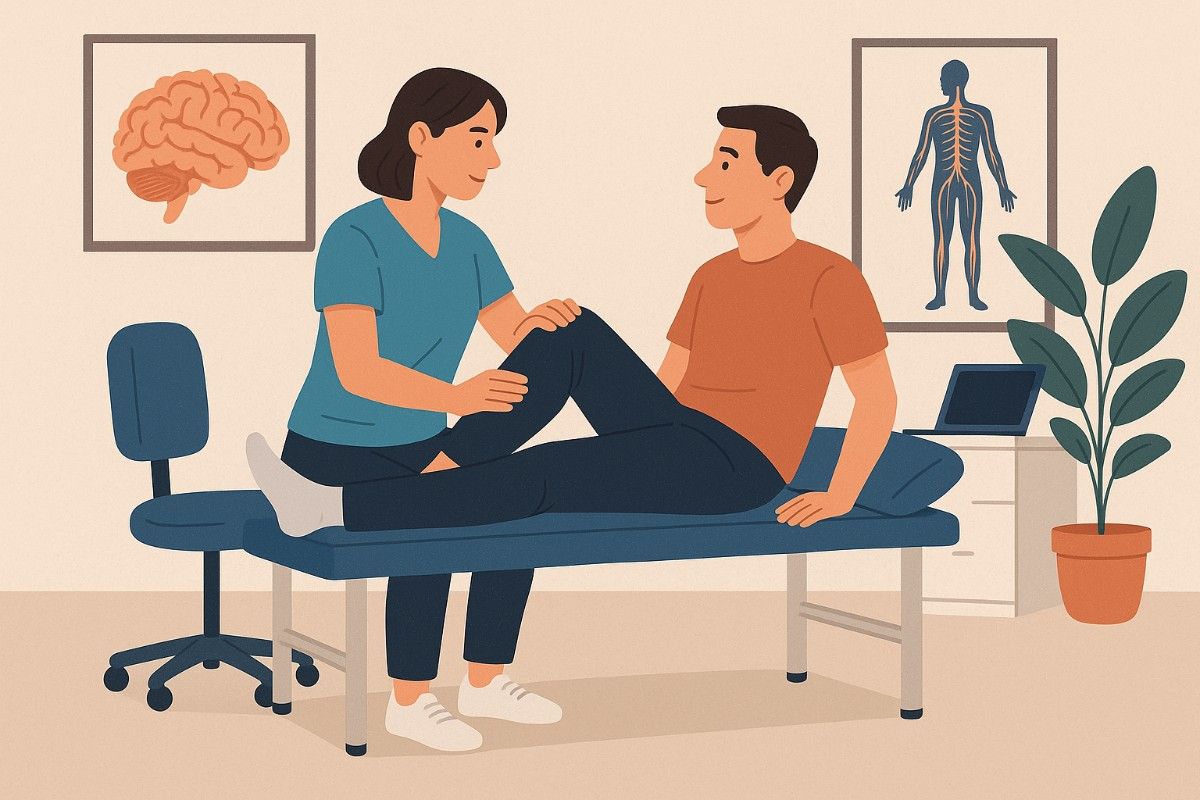Neurological physiotherapy which goes by the name neuro physiotherapy serves as a dedicated physiotherapy specialization aimed at treating people with neurological disorders or impairments. Neurological disorders develop in either the central or peripheral nervous system and result in movement control issues along with coordination and balance problems that impact functional independence. Neurological physiotherapy addresses various conditions including stroke, Parkinson’s disease, multiple sclerosis, spinal cord injuries, traumatic brain injuries, cerebral palsy, and neuropathies.
All voluntary and involuntary movements fall under the control of the nervous system. When diseases or injuries damage the nervous system patients lose movement control and face muscle weakness or paralysis along with poor balance and coordination. Neurological physiotherapy utilizes scientific exercises and techniques to retrain the brain and spinal cord which helps patients recover their lost functions and enhance their quality of life.
Neurological physiotherapy focuses on helping patients regain function while enhancing their independence and quality of life despite neurological impairments. These goals are:
1. Restore Movement and Motor Function
The main goal is to train patients to regain or relearn movement control in specific body parts. This involves:
Improving muscle strength and tone
Increasing joint range of motion
Retraining the brain through repetition and neuroplasticity
2. Improve Balance and Coordination
Neurological conditions often disrupt balance and coordination. The practice of physiotherapy involves targeted methods including proprioceptive training and gait training as well as vestibular rehabilitation to regain postural stability and reduce fall risks.
3. Enhance Functional Independence
Performing daily activities such as walking, dressing, eating, and using the bathroom plays a crucial role in maintaining patient dignity and mental health. Physiotherapy implements taskspecific training methods to enable patients to recover their independent living capabilities.
4. Prevent Secondary Complications
Immobility in neurological patients can lead to:
Joint contractures
Pressure sores
Muscle atrophy
Respiratory issues
Physiotherapists prevent complications by utilizing passive and active exercises along with proper positioning and movement facilitation.
5. Promote Neuroplasticity
The brain demonstrates neuroplasticity by developing new neural connections which allow it to reorganize its structure. Through repetitive physiotherapy exercises that focus on specific goals patients experience brain neuroplasticity which enables unaffected brain regions to assume lost functions.
6. Reduce Spasticity and Tone Abnormalities
Spasticity represents increased muscle tone which frequently occurs in people who have cerebral palsy or stroke. The management of these abnormalities can be achieved through stretching techniques, splinting methods, and electrotherapy treatment.
7. Provide Psychological and Social Support
Neurological patients often experience anxiety disorders alongside depression and social isolation. A structured physiotherapy program helps patients maintain mental health by establishing motivation through routine and progress tracking.
Common Conditions Treated
Patients with various medical conditions receive treatment from neurological physiotherapists.
1. Stroke (Cerebrovascular Accident)
2. Parkinson’s Disease
3. Multiple Sclerosis (MS)
4. Spinal Cord Injuries
5. Traumatic Brain Injury (TBI)
6. Cerebral Palsy (CP)
7. Motor Neuron Disease (MND)
8. Peripheral Neuropathy
9. GuillainBarré Syndrome
10. Ataxia and Dystonia
Techniques and Interventions in Neurological Physiotherapy
Neurological physiotherapy combines traditional methods with modern techniques to create personalized treatment plans for each patient. These include:
Neurodevelopmental Techniques (NDT) represents a manual therapy approach which promotes standard movement patterns while suppressing abnormal muscle tone.
Proprioceptive Neuromuscular Facilitation (PNF) enhances motor control by utilizing diagonal and rotational movements.
FES delivers electrical pulses to stimulate muscle movement in underperforming muscles.
This treatment involves the brain training process which utilizes the healthy limb’s reflection to create movement illusions in the impaired limb.
Constraint-Induced Movement Therapy (CIMT) requires affected limb use by immobilizing the unaffected limb.
This training focuses on practical activities that people perform in daily life such as ascending stairs or handling spoons.
Gait Training and Balance Exercises
Modern rehabilitation settings experience better results and increased motivation through the use of Virtual Reality (VR) and Robotics.
Scope of Neurological Physiotherapy
Neurological physiotherapy continues to broaden its reach due to emerging technologies and the rising number of neurological conditions. Neurological physiotherapy encompasses clinical care and homebased rehabilitation while also covering academic training and research areas.
1. Hospitals and Rehabilitation Centers
Hospitals serve as the starting point for the rehabilitation of patients with acute neurological conditions such as stroke or spinal cord injury. Physiotherapists play a pivotal role in initiating patient movement, designing recovery plans, and working alongside various medical professionals.
2. Outpatient Clinics and Private Practice
The management of chronic neurological disorders involves extended outpatient rehabilitation programs for patients. Neurological physiotherapists evaluate patient advancements and adjust treatment objectives according to both functional performance and individual requirements.
3. Pediatric Neurology Units
Early and consistent physiotherapy interventions help children with congenital neurological disorders such as cerebral palsy, spina bifida, or developmental delays improve their motor abilities and achieve greater independence and quality of life.
4. Geriatric and Community Rehabilitation
Homebased neurorehabilitation programs that target fall prevention and teach mobility aids and energy conservation techniques help older stroke and Parkinson’s patients along with those suffering from neuropathies.
5. NeuroICU and Critical Care
Physiotherapists support ICU patients by initiating passive movements to maintain function and prevent immobilityrelated complications such as bedsores and pneumonia.
6. Academic and Research Roles
Neurological physiotherapists enhance academia through their professional training programs and research work on neuroplasticity and rehabilitation protocols plus assistive devices such as exoskeletons and AIbased rehabilitation systems.
7. Occupational and Vocational Rehabilitation
People who experience major neurological damage require reintegration into social life and employment opportunities. Physiotherapists and occupational therapists collaborate to ready patients physically for work tasks.
Multidisciplinary Collaboration
The best results from neurological physiotherapy occur when it becomes part of a multidisciplinary team. Working with neurologists, neurosurgeons, occupational therapists, speech therapists, psychologists and nurses produces complete patient care.
This collaboration helps manage complex cases involving:
Cognitive impairment
Communication issues
Behavioral challenges
Swallowing difficulties
Equipment or prosthetic needs
Challenges in Neurological Physiotherapy
Despite its benefits, neurophysiotherapy faces several challenges:
Neurological healing requires sustained patience because progress happens incrementally over time.
Patients might develop frustration as their progress remains minimal and slow.
Caregiver burnout: Longterm care often burdens families.
In rural areas and regions with fewer resources, patients often cannot access advanced rehabilitation equipment such as robots or FES systems.
To overcome these multiple obstacles physiotherapists need to demonstrate compassion and patience while remaining flexible in their approach.
The evolving field of neurological physiotherapy remains dedicated to enhancing life quality for people with neurological impairments while having significant impact through its dynamic approach. The combination of neuroscience and movement science principles enables these interventions to bring back mobility and selfreliance while restoring dignity to patients affected by illness or injury.
The increasing incidence of stroke, brain injury and neurodegenerative diseases worldwide enhances the significance and influence of neurological physiotherapy. Neurological physiotherapy stands as a foundational element in modern neurorehabilitation because it promotes neuroplasticity while preventing complications and enabling long term recovery.
– Dr. Vaibhav Dave, Head of Department
Department of Physiotherapy, Madhav University

